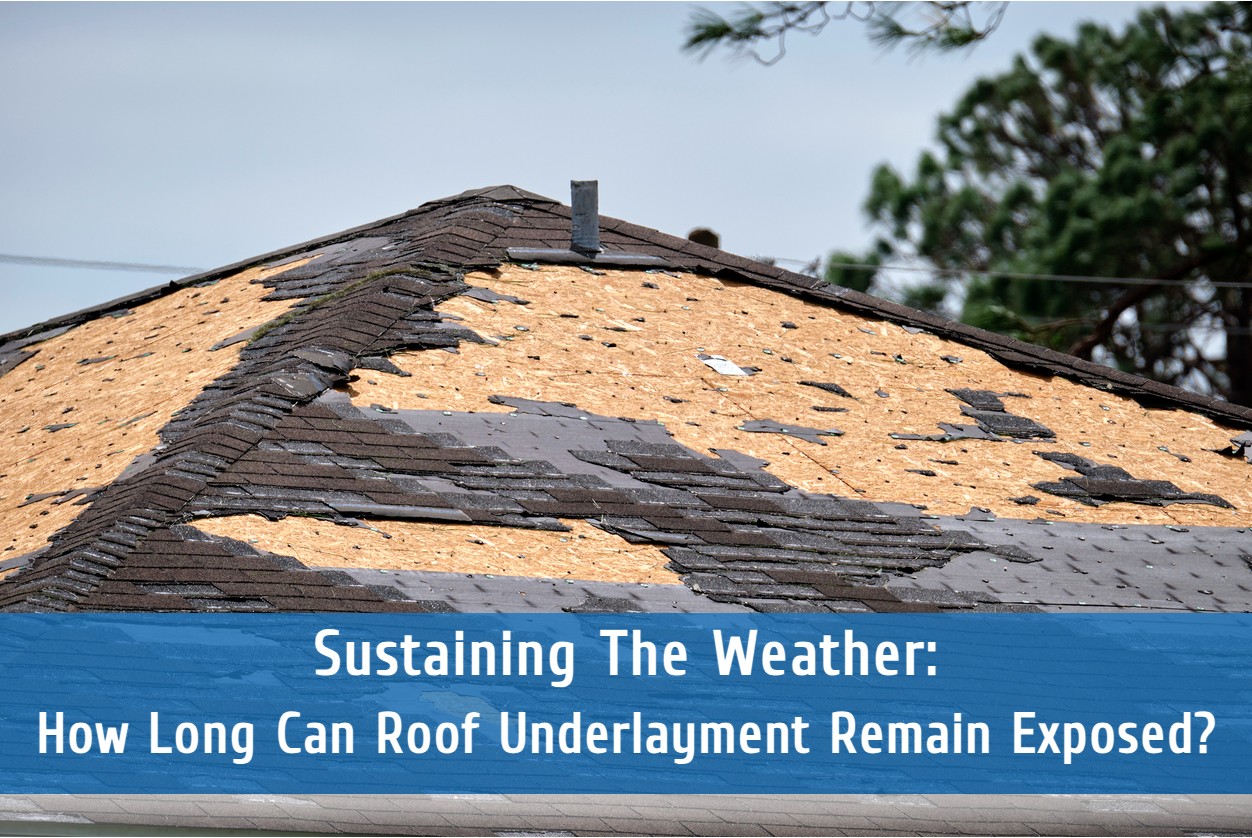When it comes to safeguarding your home from the relentless elements, the integrity of your roof is paramount. A critical yet often overlooked component in this defensive barrier is the roof underlayment. This layer, lying stealthily beneath the shingles, serves as an unsung hero in roof protection. Homeowners and contractors alike may wonder how long this material can last if left uncovered, say if a few shingles are torn off during a storm or if you’re waiting for repairs to be made. In the balmy and occasionally turbulent climate of Tampa, Florida, understanding the amount of time roof underlayment can be exposed to nature’s elements is essential to maintaining the longevity and reliability of your roofing system.
The duration or amount of exposure, along with the product’s waterproofing abilities, varies depending on the type of underlayment being used. Typically, homeowners choose between traditional felt or a more modern synthetic solution. Each has a different level of tolerance to sunlight and weather conditions, making the synthetic vs. felt underlayment exposure debate a hot topic among regional roofing contractors. Knowing the ways to protect roof underlayment from the weather can make the difference between a roof that stands the test of time and one that succumbs to the elements.
The Lifespan Of Roof Underlayment When Exposed To The Elements
The question of how long roof underlayment can be exposed to the elements is a pressing concern for any roofing project. In an ideal scenario, underlayment should be covered by shingles or other roofing materials as soon as possible to ensure maximum protection. However, delays can happen, and the underlayment may be left exposed. It’s crucial to recognize that the amount of time roof underlayment can be exposed can be significantly affected by Tampa’s humid subtropical climate, which includes strong ultraviolet (UV) rays, heavy rainfall, and at times, hurricane-strength winds.
Traditional felt underlayment, also known as tar paper, is generally rated to withstand exposure to the elements for a short period of around 30 to 90 days. On the other hand, modern synthetic underlayments are engineered for extended exposure, with some brands claiming to remain effective for six months to a year. Despite these ratings, it is always best practice to minimize the duration of time roofing felt is exposed to prevent degradation of its waterproofing capabilities.
It is worth noting that protecting the underlayment from extended exposure is not just about durability, but also about maintaining the integrity of the roof’s overall waterproofing system. For Tampa residents, choosing the right type of underlayment and understanding the limits of its exposure can save you money on costly repairs and extend the life of the roof.
Comparing The Durability Of Synthetic And Felt Underlayment When Left Exposed
Choosing the right roof underlayment is pivotal, particularly in a region like Tampa where the weather can be unforgiving. When evaluating synthetic vs. felt underlayment exposure, it’s important to consider their individual characteristics and how they hold up against the elements. Synthetic underlayments are prized for their resistance to UV radiation and their robust construction, which provides them with a longer exposure time before the installation of the top roofing layer. This can be a considerable advantage during unpredictable weather events or when construction schedules are not finalized.
In contrast, felt underlayment, while a more economical option, tends to have a shorter threshold for exposure. The duration of time in which roofing felt can be exposed is limited due to its susceptibility to tearing and water saturation, which can compromise its effectiveness as a waterproofing layer. Because of this, it requires quick coverage and diligent monitoring to prevent potential damage from prolonged exposure to the elements.
For Tampa homeowners, the decision between synthetic and felt underlayment should be informed by these factors, as well as the specific needs of their roofing projects. While synthetic underlayment may offer a more resilient barrier against the weather, the final choice will also depend on budget considerations and the anticipated timeline of the roof installation.
Effective Strategies For Protecting Roof Underlayment From The Weather
While understanding the limits of exposure for different underlayment materials is crucial, taking proactive steps to protect your roof underlayment from the weather is equally important. Homeowners in Tampa, with its unpredictable weather patterns, must be particularly alert. One effective strategy is to schedule roofing projects during drier seasons, minimizing the likelihood of weather-related delays and extended exposure times. However, when scheduling conflicts or sudden weather changes occur, it’s important to employ temporary protective measures.
Tarps or plastic sheets can be used as a temporary shield against rain and sunlight, thereby extending the amount of time roof underlayment can be exposed, safeguarding the material’s integrity. Additionally, ensuring that the underlayment is properly fastened and secured can reduce the risk of wind damage, which is a common concern in areas prone to storms and hurricanes. By implementing these protective strategies, the waterproofing capabilities of the underlayment can be maximized, ultimately contributing to a more durable and long-lasting roofing system.
It’s important for Tampa residents to recognize that while synthetic underlayment may offer a more extended window of exposure, it still requires protection to perform at its best. Regardless of the chosen material, protecting roof underlayment from the weather should always be a top priority to ensure the longevity of your roof and the safety of your home.
Tips For Promptly Applying Roofing Materials Over Exposed Underlayment
The key to ensuring that the roof underlayment exposure time does not exceed safe limits is applying the roofing materials quickly afterward. For Tampa’s roofing contractors, this means keeping a close eye on the weather forecast and project timelines. Quick and efficient workmanship is critical to avoid leaving underlayment vulnerable to the region’s harsh sun, unexpected rain, or high winds. By coordinating with a reliable team that understands the urgency of covering exposed underlayment, homeowners can significantly reduce the risk of weather-related damage.
Additionally, contractors must stay well-informed about the latest advancements in underlayment materials. The amount of time the roofing felt is exposed can be reduced by opting for high-quality, weather-resistant options that cater specifically to Tampa’s climate. By choosing materials with a proven track record of handling shorter exposure times, the overall protective capabilities are enhanced, providing homeowners with peace of mind.
Roofing projects are a substantial investment, and taking the necessary measures to protect that investment from the start is important. By adhering to best practices, Tampa’s roofing contractors can ensure that the underlayment, and by extension, the entire roof, remains secure and effective for years to come.
Warning Signs: When To Replace Your Exposed Roof Underlayment
Identifying the warning signs that necessitate the replacement of exposed roof underlayment is critical for maintaining the structural integrity of your Tampa home’s roofing system. One clear indicator is visible damage, such as tears or holes in the underlayment, which can compromise its ability to repel water. Homeowners should also be wary of any discoloration or signs of mold growth, as these can signal that moisture has penetrated through the roofing material, potentially leading to more severe issues like wood rot or leaks.
Another telltale sign is the presence of excessive granules from shingles that have accumulated on top of the underlayment, a result of shingle wear that could expose the underlayment to the elements. For Tampa residents, it’s especially important to monitor the roof underlayment after severe weather events. Should any of these warning signs be present, it’s advisable to consult with a professional roofing contractor to assess the underlayment’s condition and discuss whether a replacement is necessary to secure your home from the unpredictable tropical climate.
Expert Recommendations For Underlayment Selection And Maintenance
Selecting the right roof underlayment is a decision that requires careful consideration, especially in regions like Tampa where weather can be severe. Roofing experts recommend choosing underlayment materials that are best suited to the local climate. For example, synthetic underlayments might be preferred due to their ability to be exposed longer, and are more durable against UV rays and moisture. However, the specific needs and budget of the homeowner should always be taken into account when choosing between synthetic and felt underlayment.
Maintenance is another key factor in preserving a waterproof underlayment’s lifespan. Regular inspections are essential, particularly after extreme weather events, to detect any signs of damage or wear. Prompt repairs and maintenance can prevent minor issues from becoming major problems, ensuring that the underlayment continues to provide reliable protection for your home.
Ultimately, the longevity of your roofing system heavily relies on both the quality of the underlayment selected and the commitment to ongoing maintenance. By following these expert tips, Tampa homeowners can secure their investment and enjoy a roof that remains robust and weather-resistant year after year.
We Can Help You Protect Exposed Roof Underlayment In Tampa, Fl
If you’re in Tampa, ensuring your roof underlayment is protected from the elements is crucial. SouthShore Roofing & Exteriors specializes in providing expert solutions to safeguard your underlayment. Don’t wait until it’s too late, contact us at (813) 400-3329 to schedule a consultation and protect your underlayment and roof today.




